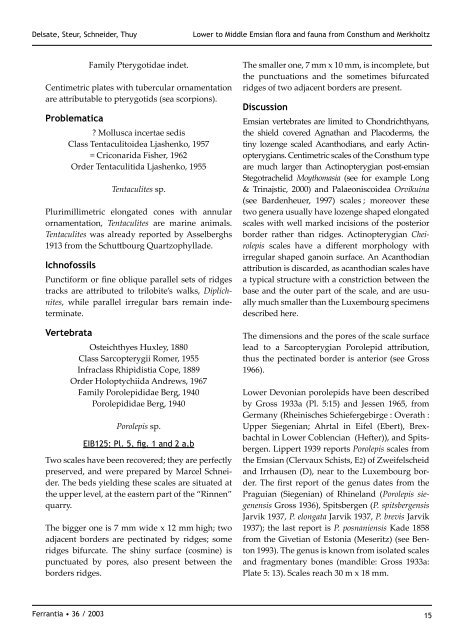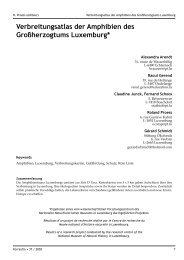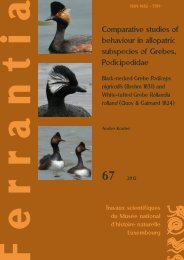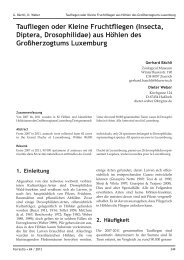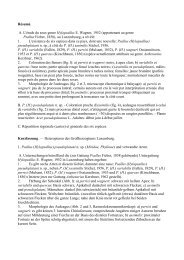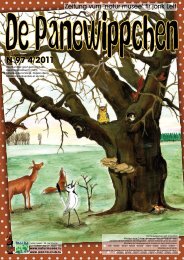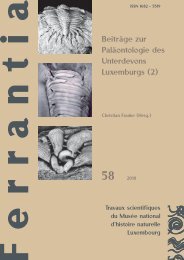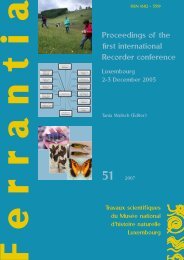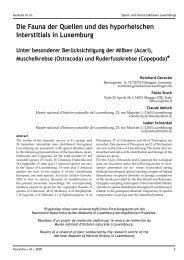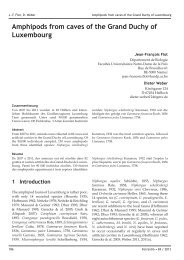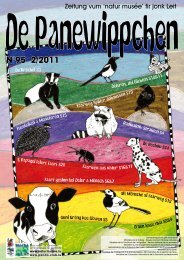Publi.complète - Musée national d'histoire naturelle
Publi.complète - Musée national d'histoire naturelle
Publi.complète - Musée national d'histoire naturelle
You also want an ePaper? Increase the reach of your titles
YUMPU automatically turns print PDFs into web optimized ePapers that Google loves.
Delsate, Steur, Schneider, Thuy Lower to Middle Emsian flora and fauna from Consthum and Merkholtz<br />
Ferrantia • 36 / 2003<br />
Family Pterygotidae indet.<br />
Centimetric plates with tubercular ornamentation<br />
are aributable to pterygotids (sea scorpions).<br />
Problematica<br />
? Mollusca incertae sedis<br />
Class Tentaculitoidea Ljashenko, 1957<br />
= Criconarida Fisher, 1962<br />
Order Tentaculitida Ljashenko, 1955<br />
Tentaculites sp.<br />
Plurimillimetric elongated cones with annular<br />
ornamentation, Tentaculites are marine animals.<br />
Tentaculites was already reported by Asselberghs<br />
1913 from the Schubourg Quartzophyllade.<br />
Ichnofossils<br />
Punctiform or fine oblique parallel sets of ridges<br />
tracks are aributed to trilobite’s walks, Diplichnites,<br />
while parallel irregular bars remain indeterminate.<br />
Vertebrata<br />
Osteichthyes Huxley, 1880<br />
Class Sarcopterygii Romer, 1955<br />
Infraclass Rhipidistia Cope, 1889<br />
Order Holoptychiida Andrews, 1967<br />
Family Porolepididae Berg, 1940<br />
Porolepididae Berg, 1940<br />
Porolepis sp.<br />
EIB125: Pl. 5, fig. 1 and 2 a,b<br />
Two scales have been recovered; they are perfectly<br />
preserved, and were prepared by Marcel Schneider.<br />
The beds yielding these scales are situated at<br />
the upper level, at the eastern part of the “Rinnen”<br />
quarry.<br />
The bigger one is 7 mm wide x 12 mm high; two<br />
adjacent borders are pectinated by ridges; some<br />
ridges bifurcate. The shiny surface (cosmine) is<br />
punctuated by pores, also present between the<br />
borders ridges.<br />
The smaller one, 7 mm x 10 mm, is incomplete, but<br />
the punctuations and the sometimes bifurcated<br />
ridges of two adjacent borders are present.<br />
Discussion<br />
Emsian vertebrates are limited to Chondrichthyans,<br />
the shield covered Agnathan and Placoderms, the<br />
tiny lozenge scaled Acanthodians, and early Actinopterygians.<br />
Centimetric scales of the Consthum type<br />
are much larger than Actinopterygian post-emsian<br />
Stegotrachelid Moythomasia (see for example Long<br />
& Trinajstic, 2000) and Palaeoniscoidea Orvikuina<br />
(see Bardenheuer, 1997) scales ; moreover these<br />
two genera usually have lozenge shaped elongated<br />
scales with well marked incisions of the posterior<br />
border rather than ridges. Actinopterygian Cheirolepis<br />
scales have a different morphology with<br />
irregular shaped ganoin surface. An Acanthodian<br />
aribution is discarded, as acanthodian scales have<br />
a typical structure with a constriction between the<br />
base and the outer part of the scale, and are usually<br />
much smaller than the Luxembourg specimens<br />
described here.<br />
The dimensions and the pores of the scale surface<br />
lead to a Sarcopterygian Porolepid aribution,<br />
thus the pectinated border is anterior (see Gross<br />
1966).<br />
Lower Devonian porolepids have been described<br />
by Gross 1933a (Pl. 5:15) and Jessen 1965, from<br />
Germany (Rheinisches Schiefergebirge : Overath :<br />
Upper Siegenian; Ahrtal in Eifel (Ebert), Brexbachtal<br />
in Lower Coblencian (Heer)), and Spitsbergen.<br />
Lippert 1939 reports Porolepis scales from<br />
the Emsian (Clervaux Schists, E2) of Zweifelscheid<br />
and Irrhausen (D), near to the Luxembourg border.<br />
The first report of the genus dates from the<br />
Praguian (Siegenian) of Rhineland (Porolepis siegenensis<br />
Gross 1936), Spitsbergen (P. spitsbergensis<br />
Jarvik 1937, P. elongata Jarvik 1937, P. brevis Jarvik<br />
1937); the last report is P. posnaniensis Kade 1858<br />
from the Givetian of Estonia (Meseritz) (see Benton<br />
1993). The genus is known from isolated scales<br />
and fragmentary bones (mandible: Gross 1933a:<br />
Plate 5: 13). Scales reach 30 m x 18 mm.<br />
15


